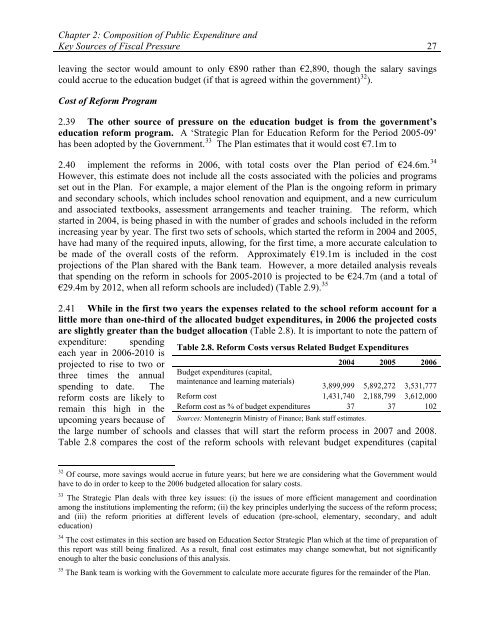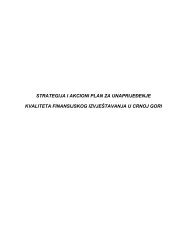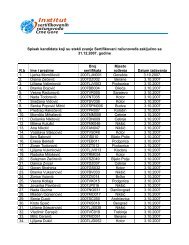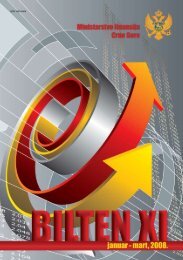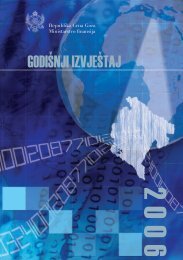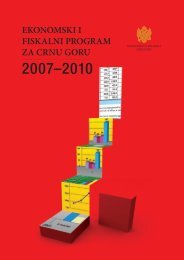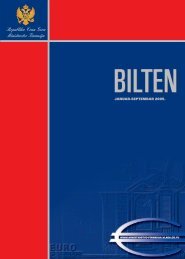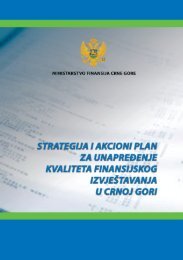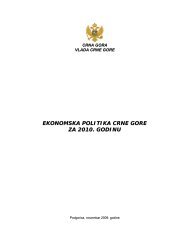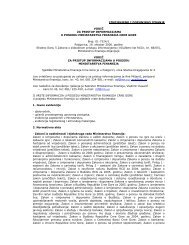Republic of Montenegro: Public Expenditure and ... - Vlada Crne Gore
Republic of Montenegro: Public Expenditure and ... - Vlada Crne Gore
Republic of Montenegro: Public Expenditure and ... - Vlada Crne Gore
You also want an ePaper? Increase the reach of your titles
YUMPU automatically turns print PDFs into web optimized ePapers that Google loves.
Chapter 2: Composition <strong>of</strong> <strong>Public</strong> <strong>Expenditure</strong> <strong>and</strong><br />
Key Sources <strong>of</strong> Fiscal Pressure 27<br />
leaving the sector would amount to only €890 rather than €2,890, though the salary savings<br />
could accrue to the education budget (if that is agreed within the government) 32 ).<br />
Cost <strong>of</strong> Reform Program<br />
2.39 The other source <strong>of</strong> pressure on the education budget is from the government’s<br />
education reform program. A ‘Strategic Plan for Education Reform for the Period 2005-09’<br />
has been adopted by the Government. 33 The Plan estimates that it would cost €7.1m to<br />
2.40 implement the reforms in 2006, with total costs over the Plan period <strong>of</strong> €24.6m. 34<br />
However, this estimate does not include all the costs associated with the policies <strong>and</strong> programs<br />
set out in the Plan. For example, a major element <strong>of</strong> the Plan is the ongoing reform in primary<br />
<strong>and</strong> secondary schools, which includes school renovation <strong>and</strong> equipment, <strong>and</strong> a new curriculum<br />
<strong>and</strong> associated textbooks, assessment arrangements <strong>and</strong> teacher training. The reform, which<br />
started in 2004, is being phased in with the number <strong>of</strong> grades <strong>and</strong> schools included in the reform<br />
increasing year by year. The first two sets <strong>of</strong> schools, which started the reform in 2004 <strong>and</strong> 2005,<br />
have had many <strong>of</strong> the required inputs, allowing, for the first time, a more accurate calculation to<br />
be made <strong>of</strong> the overall costs <strong>of</strong> the reform. Approximately €19.1m is included in the cost<br />
projections <strong>of</strong> the Plan shared with the Bank team. However, a more detailed analysis reveals<br />
that spending on the reform in schools for 2005-2010 is projected to be €24.7m (<strong>and</strong> a total <strong>of</strong><br />
€29.4m by 2012, when all reform schools are included) (Table 2.9). 35<br />
2.41 While in the first two years the expenses related to the school reform account for a<br />
little more than one-third <strong>of</strong> the allocated budget expenditures, in 2006 the projected costs<br />
are slightly greater than the budget allocation (Table 2.8). It is important to note the pattern <strong>of</strong><br />
expenditure: spending<br />
each year in 2006-2010 is<br />
projected to rise to two or<br />
three times the annual<br />
spending to date. The<br />
reform costs are likely to<br />
remain this high in the<br />
upcoming years because <strong>of</strong><br />
Table 2.8. Reform Costs versus Related Budget <strong>Expenditure</strong>s<br />
2004 2005 2006<br />
Budget expenditures (capital,<br />
maintenance <strong>and</strong> learning materials)<br />
3,899,999 5,892,272 3,531,777<br />
Reform cost 1,431,740 2,188,799 3,612,000<br />
Reform cost as % <strong>of</strong> budget expenditures 37 37 102<br />
Sources: Montenegrin Ministry <strong>of</strong> Finance; Bank staff estimates.<br />
the large number <strong>of</strong> schools <strong>and</strong> classes that will start the reform process in 2007 <strong>and</strong> 2008.<br />
Table 2.8 compares the cost <strong>of</strong> the reform schools with relevant budget expenditures (capital<br />
32 Of course, more savings would accrue in future years; but here we are considering what the Government would<br />
have to do in order to keep to the 2006 budgeted allocation for salary costs.<br />
33 The Strategic Plan deals with three key issues: (i) the issues <strong>of</strong> more efficient management <strong>and</strong> coordination<br />
among the institutions implementing the reform; (ii) the key principles underlying the success <strong>of</strong> the reform process;<br />
<strong>and</strong> (iii) the reform priorities at different levels <strong>of</strong> education (pre-school, elementary, secondary, <strong>and</strong> adult<br />
education)<br />
34 The cost estimates in this section are based on Education Sector Strategic Plan which at the time <strong>of</strong> preparation <strong>of</strong><br />
this report was still being finalized. As a result, final cost estimates may change somewhat, but not significantly<br />
enough to alter the basic conclusions <strong>of</strong> this analysis.<br />
35 The Bank team is working with the Government to calculate more accurate figures for the remainder <strong>of</strong> the Plan.


